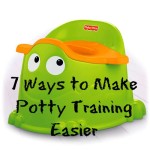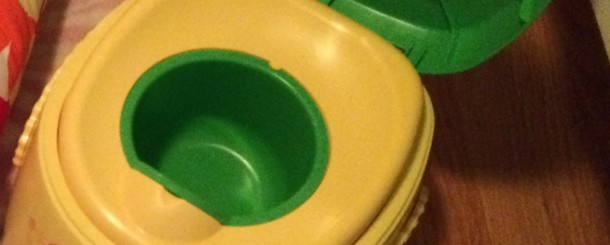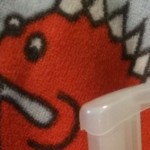Note from Hint Mama: I’m right in the midst of potty training my 2.5-year-old daughter, and it’s no secret that potty training is hard. In fact, the difficulty of potty training is why my posting frequency has gone down a bit lately – I’m spending my free time cleaning up accidents and watching my tot closely. However, I’m sure the process would be even harder if I didn’t have potty training hints from contributor Karen Witham, a been-there, done-that mom, to help me. Here’s the latest in her series of posts looking back at what she learned from potty training her two children.
Potty training is something all kids and parents go through. It’s emotional, time consuming, occasionally very messy, and can be a real hassle. However, from experience, I’ve learned that there are ways to make it a bit less stressful for you and your child. Today’s hint is seven tips that can help make potty training as easy as possible.
1. Dress your child for potty training success. In an earlier post here on Hint Mama, I suggested ways to dress your tot to help support potty training. Think commando, skirts and t-shirts, and skip the overalls and footsie pajamas.
 2. Pepper your house with toddler potties. I suggest buying a couple of those portable toddler potties (I like the Fisher-Price Froggy Potty). Put one in your child’s bedroom, so going potty at night or first thing in the morning is convenient. Put another one in the most popular room in the house, like the playroom or family room.
2. Pepper your house with toddler potties. I suggest buying a couple of those portable toddler potties (I like the Fisher-Price Froggy Potty). Put one in your child’s bedroom, so going potty at night or first thing in the morning is convenient. Put another one in the most popular room in the house, like the playroom or family room.
3. Don’t forget the wipes. I also put a box of diaper wipes next to the potty. I think wet wipes are gentler than toilet paper, and more likely to help them do a good job getting cleaned up.
4. Regulate fluids. Don’t allow a big drink just before a long car trip, in the car, or before bedtime, to help lessen the chance of accidents and save yourself some cleanup time.
5. Help your child form good bathroom habits. Make it part of the routine to use the bathroom before leaving the house and right before bed. It helps if the entire family does this, so your child doesn’t feel singled out. And be sure to read this earlier hint on instilling good bathroom manners.
6. Teach your child how to look for bathrooms. Try to make your little one feel safe in being able to ask to go to the bathroom — even if it’s annoying or inconvenient. Point out the restroom when you pass by one, and familiarize them with the symbols for women’s and men’s restrooms – they can serve as a visual cue.
7. Engage in potty talk. Spend some time each day talking to your child about his or her feelings, and occasionally weave in some questions about using the bathroom. If you are used to being around adults all day, like I am, it can be hard to say things like, “How does your body feel today?” “How was it when you went to the bathroom today? Did it feel good, did anything hurt?” “Are you feeling proud that you used the potty this morning?” “What can I do to help you?” “Do you like your frog potty? How do you feel about using the toilet mommy and daddy use?”
If we don’t openly talk to our little ones about the basics of using the toilet, how can we expect them to know how to talk to us about their potty training challenges, fears, and needs? What if the main barrier to using the toilet is that the flushing noise scares your toddler? What if your child has mild constipation and it hurts them to go? What if their toddler potty is uncomfortable for them or hard to get up from? You may never know unless you ask.
It’s a fine line – don’t obsess or force your child to have daily conversations about potty training. If it’s just one of the many areas of life that you discuss, and in which you are interested in their feelings, potty talk should be relatively natural and a positive experience for you both.
Now, just a couple caveats: these tips are meant for those of you potty training toddlers and preschoolers, not infants. And of course, I’m not an expert. I’m just a mom. But I do have potty training experience and the gift of a little hindsight (my kids are both in elementary school now). I hope these tips prove helpful or at least, thought-provoking.
What are your tips for making the potty training process easier?
Karen Witham is a mother of two children who she can’t believe are already ages five and seven. She spends her time on both sides of the Bay, working full-time as an editor and writer in San Francisco and living in Oakland. A transplant from the East Coast, she spent ten years living in Boston and also loves New York and most of all, Paris. Karen has a B.A. from Brown University and an M.A. from Emerson College. She blogs at Thoughtstream. Connect with her on Twitter at @kewitham or LinkedIn.
Follow Hint Mama on Facebook and Twitter, and read more about her and her disclosures.







1, 2, 3, 5, & 7 apply to infants just as much as any kid. You might be able to do a little of 4 but keep an eye on weight gain. Probably not worth the risk. Obviously 6 is over an infants head.